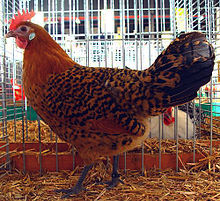 Gold hen Gold hen | |
| Country of origin | Germany |
|---|---|
| Traits | |
| Weight |
|
| Egg colour | white |
| Classification | |
| |


The Ostfriesische Möwe (German pronunciation: [ˈɔstˌfʁiːzɪʃə ˈmøːvə], lit. 'East Frisian Gull') is an old German breed of domestic chicken. It is a rare breed: in 2016 the recorded population in Germany consisted of 215 cocks and 979 hens, in the hands of 130 breeders. Its conservation status is gefährdet, "endangered".
History
The Möwe derives from the traditional rural chickens of north-western Germany and north-eastern Holland, in East Friesland and West Friesland respectively. It is closely related to the Westfälische Totleger and the Braekel.
Characteristics
It is kept in two colour varieties: silver-pencilled and gold-pencilled. Cocks weigh up to 3 kg and hens up to 2.5 kg. Hens lay about 170 eggs per year, averaging 55 g in weight.
References
- ^ Einheimische Nutztierrassen in Deutschland und Rote Liste gefährdeter Nutztierrassen 2017 (in German). Bundesanstalt für Landwirtschaft und Ernährung. Accessed September 2018.
| Chicken breeds of the Netherlands | |
|---|---|
| These are the chicken breeds considered in the Netherlands to be wholly or partly of Dutch origin. Inclusion here does not necessarily imply that a breed is predominantly or exclusively Dutch. | |
|
This Germany-related article is a stub. You can help Misplaced Pages by expanding it. |
This poultry article is a stub. You can help Misplaced Pages by expanding it. |